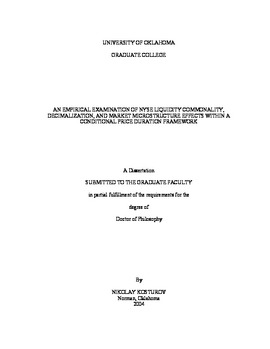| dc.contributor.advisor | Linn, Scott C., | en_US |
| dc.contributor.author | Kosturov, Nikolay. | en_US |
| dc.date.accessioned | 2013-08-16T12:19:26Z | |
| dc.date.available | 2013-08-16T12:19:26Z | |
| dc.date.issued | 2004 | en_US |
| dc.identifier.uri | https://hdl.handle.net/11244/745 | |
| dc.description.abstract | This study utilizes TAQ data for 40 NYSE stocks to apply a transaction signing, filtering, and aggregation algorithm in order to isolate price durations, defined as the length of time necessary for prices to move in either direction by at least a pre-specified increment. An Autoregressive Conditional Duration (ACD) model is applied to test an array of informational microstructure effects and assumptions of empirical distributions. A matched sample of decimal pilot and control stocks over two sample periods allows a tests for the effect of decimalization on volatility, price, and liquidity formation processes. My results indicate that after the complete switch to decimalization, the price formation process adjusted to the new trading regime, and the dynamics of expected conditional duration and liquidity remained quite stable and uniform in terms of the new ACD and realized depth model coefficients respectively. Decimalization seems to have reduced conditional mid-quote price volatility by making the average conditional expectation of time necessary for a predetermined price change slightly larger. There is also moderate evidence that over the test sample period, liquidity formation dynamics were in fact affected negatively by the decimal pricing grid. In addition, realized market depth and orthogonalized liquidity series are examined for common factors, identifying a single influential component behind liquidity covariation. Commonality evidence disappears after accounting for microstructure and volatility effects, hinting at the possible identity of the factor, and confirming the validity of thy study's duration predicated, event-time analysis that synthetically binds the price and subsumed liquidity formation processes. | en_US |
| dc.format.extent | v, 239 leaves : | en_US |
| dc.subject | New York Stock Exchange. | en_US |
| dc.subject | Stocks Prices New York (State) New York Econometric models. | en_US |
| dc.subject | Stocks Prices Econometric models. | en_US |
| dc.subject | Economics, Finance. | en_US |
| dc.title | An empirical examination of NYSE liquidity commonality, decimalization, and market microstructure effects within a conditional price duration framework. | en_US |
| dc.type | Thesis | en_US |
| dc.thesis.degree | Ph.D. | en_US |
| dc.thesis.degreeDiscipline | Michael F. Price College of Business | en_US |
| dc.note | Adviser: Scott C. Linn. | en_US |
| dc.note | Source: Dissertation Abstracts International, Volume: 65-05, Section: A, page: 1897. | en_US |
| ou.identifier | (UMI)AAI3134387 | en_US |
| ou.group | Michael F. Price College of Business | |
